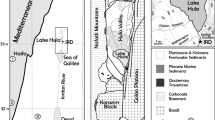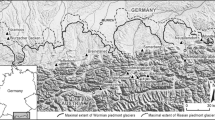Abstract
As many as 2500 interdune lakes lie within the Nebraska Sand Hills, a 50 000 km stabilized sand sea. The few published data on cores from these lakes indicate they are typically underlain by less than two m of Holocene lacustrine sediments. However, three lakes in the southwestern Sand Hills, Swan, Blue, and Crescent, contain anomalously thick marsh (peat) and lacustrine (gyttja) sediments. Swan Lake basin contains as much as 8 m of peat, which was deposited between about 9000 and 3300 years ago. This peat is conformably overlain by as much as 10.5 m of gyttja. The sediment record in Blue lake, which is 3 km downgradient from Swan lake, dates back to only about 6000 years ago. Less than two m of peat, which was deposited from 6000 to 5000 years ago, is overlain by 12 m of gyttja deposited in the last 4300 years. Crescent Lake basin, one km downgradient from Blue Lake, has a similar sediment history except for a lack of known peat deposits. Recently, a 8-km long segment of a paleovalley was documented running beneath the three lakes and connecting to the head of Blue Creek Valley. Blockage of this paleovalley by dune sand during two arid intervals, one shortly before 10 500 yr BP and one in the mid-Holocene, has resulted in a 25 m rise in the regional water table. This made possible the deposition of organic-rich sediment in all three lakes. Although these lakes, especially Swan, would seem ideal places to look for a nearly complete record of Holocene climatic fluctuations, the paleoclimatic record is confounded by the effect dune dams have on the water table. In Swan Lake, the abrupt conversion from marsh to lacustrine deposition 3300 years ago does not simply record the change to a wetter regional climate; it reflects the complex local hydrologic changes surrounding the emplacement and sealing of dune dams, as well as regional climate.
Similar content being viewed by others
References
Cushing, E. J. & H. E. Wright, 1965. Hand-operated piston corers for lake sediments. Ecology 46: 380–384.
Gosselin, D. C., S. Sibray & J. Ayers, 1994. Geochemistry of Krich alkaline lakes, Western Sandhills, Nebraska, USA. Geoch. Cosmoch. Acta 58: 1403–1418.
Loope, D. B., J. B. Swinehart & J. P. Mason, 1995. Dune-dammed paleovalleys of the Nebraska Sand Hills: intrinsic vs climatic controls on the accumulation of lake and marsh sediments. GSA Bull. 107: 396–406.
Loope, D. M., 1995. Reconstruction of changes in salinity of Swan Lake in the Nebraska Sand Hills based on diatoms in the sediments. MSc thesis, Northern Michigan University, Marquette, Minnesota, USA, 98 pp.
Mason, J., 1995, Influence of blocked drainages on the paleoclimate record of the western Sand Hills of Nebraska. MSc thesis, University of Nebraska-Lincoln, Lincoln, Nebraska, USA, 131 pp.
McCarraher, D. B., 1977. Nebraska's Sandhills Lakes. Nebraska Game and Parks Commission, 67 pp.
Rundquist, D. C., 1983. Wetland Inventories of Nebraska's Sandhills. Resource Report, University of Nebraska, Lincoln; Conservation and Survey Division, 9: 46 pp.
Thompson, T. A., C. S. Miller, P. K. Doss, L. D. P. Thompson S. J. Baedke, 1991. Land-based vibracoring and vibracore analysis; tips, tricks, and traps. Indiana Geological Survey Occasional Paper, 13 pp.
Winter, T. C., 1986. Effect on ground-water recharge on configuration of the water table beneath sand dunes and on seepage in lakes in the Sandhills of Nebraska, USA. J. Hydrol. 86: 221–237.
Wright, H. E. Jr., J. C. Almendinger & J. Gruger, 1985. Pollen diagram from the Nebraska Sandhills and the age of the dunes. Quat. Res. 24: 115–120.
Author information
Authors and Affiliations
Corresponding author
Rights and permissions
About this article
Cite this article
Mason, J.P., Swinehart, J.B. & Loope, D.B. Holocene history of lacustrine and marsh sediments in a dune-blocked drainage, Southwestern Nebraska Sand Hills, U.S.A.. Journal of Paleolimnology 17, 67–83 (1997). https://doi.org/10.1023/A:1007917110965
Issue Date:
DOI: https://doi.org/10.1023/A:1007917110965




